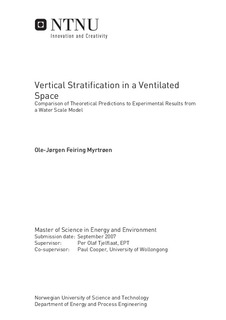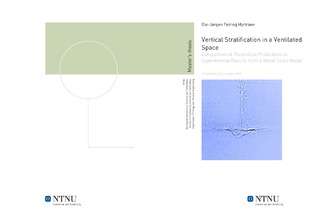| dc.contributor.advisor | Tjelflaat, Per Olaf | nb_NO |
| dc.contributor.advisor | Cooper, Paul | nb_NO |
| dc.contributor.author | Myrtrøen, Ole-Jørgen Feiring | nb_NO |
| dc.date.accessioned | 2014-12-19T11:44:21Z | |
| dc.date.available | 2014-12-19T11:44:21Z | |
| dc.date.created | 2010-09-03 | nb_NO |
| dc.date.issued | 2007 | nb_NO |
| dc.identifier | 347580 | nb_NO |
| dc.identifier | ntnudaim:3390 | nb_NO |
| dc.identifier.uri | http://hdl.handle.net/11250/233586 | |
| dc.description.abstract | This study investigates the behaviour of a vertically distributed source of buoyancy on the vertical stratification in a ventilated space, an important factor for determining indoor comfort when using displacement ventilation. A new theory describing the behaviour of this buoyancy source in a ventilated space was presented previous to this work, but experimental results were required in order to validate the theoretical and numerical modelling. The behaviour of this source of buoyancy on the stratification in a ventilated space is studied for a mechanically ventilated at steady-state and for a linearly stratified environment using salt water in a water scale model. The stratifications were measured using a traversing conductivity probe and then compared to theoretical predictions by numerically solving the plume equations for the new theory in Fortran. High quality measurements were produced, showing excellent repeatability for stratification measurements at steady-state with deviations of less than 1 %. Moreover, the linear stratifications had linear best fits up to R2 = 0.999 by using the double-bucket method. The theoretical predictions of the influence of the vertically distributed source correlate quantitatively with the mechanically ventilated experiments, showing good agreement to the strength of the ambient stratification, the position of the first front and the ventilation flow rate. The experimental results for the determination of the height of a horizontal intrusion of fluid into the linearly stratified environment were severely affected by the occurrence of gravity current at the ceiling of the ventilated space and comparisons to the new theory was not successful because of this. A two-layer stratification is observed where the upper layer had a weakly stratified density profile, instead of the multi-layer stratification predicted by previous researchers in their theoretical model. This discrepancy is due to smoothing and vertical turbulent mixing in the water scale model. It is recommended that the characteristic of the membrane that is used in the water scale model is investigated in relation to the gravity currents for future research. | nb_NO |
| dc.language | eng | nb_NO |
| dc.publisher | Institutt for energi- og prosessteknikk | nb_NO |
| dc.subject | ntnudaim | no_NO |
| dc.subject | SIE5 energi og miljø | no_NO |
| dc.subject | Varme- og energiprosesser | no_NO |
| dc.title | Vertical Stratification in a Ventilated Space: Comparison of Theoretical Predictions to Experimental Results from a Water Scale Model | nb_NO |
| dc.type | Master thesis | nb_NO |
| dc.source.pagenumber | 143 | nb_NO |
| dc.contributor.department | Norges teknisk-naturvitenskapelige universitet, Fakultet for ingeniørvitenskap og teknologi, Institutt for energi- og prosessteknikk | nb_NO |

